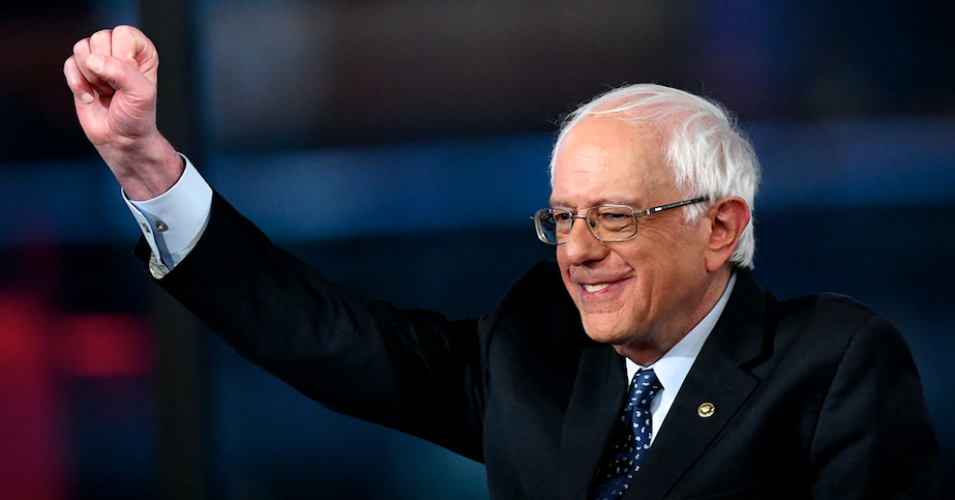With Bernie Sanders significantly in the lead heading into the Iowa caucuses, pulling ahead of Joe Biden by nearly 10% by some polls, it’s undeniable that Sanders is a real contender in the 2020 election. In a sense, this ought to come as no surprise—from the beginning of his campaign, Sanders has polled consistently at second or third place for the Democratic Party’s nomination, behind Biden and ahead of or just behind Elizabeth Warren or Pete Buttigieg. From AOC to Cardi B, Sanders racked up a number of celebrity endorsements early in his campaign. With a loyal base of supporters, his campaign rallies unfailingly attract huge crowds; in New York City alone, over 25,000 people attended a rally in Brooklyn last year.
Despite his consistently strong showing in the polls, however, he has been widely brushed off by the political establishment and media as a rabble rouser with little chance of attracting voters with his radical policies. Though forced to respond to Sanders’ proposals like Medicare for All and A Green New Deal, many of the other Democratic candidates focused on trying to siphon off each other’s support rather than spend much time directly attacking Sanders in the debates. After his heart attack in October 2019, much of the political establishment wrote him off for good, assuming that Sanders’ health and age would be the final nail in the coffin for voters.
Unlike 2016, both the bourgeois media and even the Democratic Party leadership have refrained from attacking Sanders outright. For the majority of the 2020 nomination race, the political establishment’s strategy towards Sanders has been, for the most part, to ignore him and hope he will just go away.
But since early this year, due to a confluence of factors both internal and external to Sanders’ campaign, this has begun to change. From Warren’s slip in the polls, to Sanders’ fundraising numbers and his lead in Iowa and New Hampshire, the establishment is being forced to reckon with the fact that Sanders might actually have a shot at the nomination.
Sanders Surges as the Field Narrows
Since October 2019, support for Sanders has been consistently climbing in national polls. Though he has not yet surged beyond second or third place, he has steadily gained support as the race has progressed and other nominees have dropped out. Sanders went from an all-time low of just 14% in early October to 23% in the most recent reports. He is now trailing behind Biden by only 4%, closing a 12% gap since last year.
Meanwhile, Warren, who had every appearance last fall of catching up to Biden and kicking Sanders out of second place for good, has sharply declined in the polls as support for Sanders climbs. Warren has been struggling to distinguish herself as a candidate for the last several months—wishing to appear both as an anti-establishment possibility and a conciliator who can depolarize the political arena and serve diverse interests. At the same time that she calls for an end to Wall Street’s control over the economy, she makes tepid promises to develop a more “accountable capitalism.” She vows to get the U.S. out of endless wars at the same time that she votes for an increase in the military budget. This waffling and equivocating dampened the enthusiasm she temporarily inspired in both voters and the Democratic Party leadership.
Warren began to dip in the polls in late October around the time she effectively dropped Medicare for All from her platform and it was revealed that she transferred big donor and corporation funds from her senate campaign bid to boost her presidential run. Since then, Warren has not yet been able to regain her momentum, despite several ill-fated attempts to change her campaign tactics. In the last fundraising period of 2019, her campaign failed to match previous quarters while the other top candidates surpassed their own records. While before she was seen as Sanders’ main political rival for second place, Warren is now battling with Buttigieg and Bloomberg for third place. Even her New York Times endorsement has done little to move her poll numbers.
Compared to Warren’s nosedive in the polls and Biden’s steady but stagnant lead, Sanders’ own growth in the polls is remarkable—all eyes are on him as the primaries approach.
Is This Bernie’s Moment?
Sanders isn’t just growing in the polls. His campaign had an impressive fundraising quarter at the end of 2019 which turned heads among the political caste. Sanders’ campaign was able to raise $34.5 million from October to December 2019, a number that outstrips that of the other Democratic frontrunners and comes close to matching Donald Trump’s own $46 million in fundraising for the last quarter.
As Sanders’ campaign is quick to point out, what’s remarkable about his fundraising numbers is that the funds come primarily from small donors—those who donate less than $200.Sanders’ campaign reported that it received 5 million donations this year alone, the largest number of donations a presidential campaign has ever received in U.S. history. The average yearly donation to his campaign is around $18. While Buttigieg and Biden rely on corporate donations to feed their campaigns, and Tom Steyer and Michael Bloomberg funnel millions of dollars of their personal fortunes to keep themselves afloat, Sanders’ campaign sustains itself primarily through individual donations (big and small) and contributions from non-profit organizations.
To some degree, this poses a threat to the way the political establishment conducts elections. On the one hand, it is an obvious indication that Sanders has a large base of support, one that may be decisive in the elections. On the other hand, in a campaign and electoral system that is controlled by donations from big corporations and wealthy capitalists’ donations, Sanders’ small-donor fueled funding makes him more difficult to pin down. For now at least, Sanders does not need wealthy donors’ and big business’s money to keep his campaign afloat.
In addition to his recent fundraising success, Sanders has also attracted the support of some of the U.S.’s top unions. Last week, Sanders was endorsed by the American Postal Workers Union which has 200,000 members. He has also been endorsed by National Nurses United, United Electrical, Radio, and Machine Workers, and the National Union of Healthcare Workers, as well as Local 11 (the union that tried to disrupt the Los Angeles debate). Sanders also enjoys widespread support among teachers, who make up a significant portion of his donors and volunteers. Only Biden outstrips him in terms of union support.
A Broader Leftward Turn
Of course, Sanders’ rise in the polls does not take place in a vacuum; it cannot be explained by his appeal as a political figurehead alone. In the current political and social context, Sanders is arguably better positioned—among voters at least—today than he was in 2016. Nearly four years of a Trump presidency has only exacerbated the crisis of political representation that brought Trump to power in the first place.
Concretely, what this means is that the Democratic Party and its corporate interests are struggling to find an acceptable pick for the 2020 election. So far, they’ve come up short, as is evidenced by the fact that the political and financial support of the U.S.’s capitalist interests is still divided among the candidates. Though Biden has remained in the lead for almost the entirety of his campaign, the Democratic Party has not decided to throw its weight behind him just yet; he has not been able to secure consistent funding and political support compared to other candidates. Buttigieg, for example, enjoys significant support from Wall Street and among wealthy donors; meanwhile, in the third fundraising quarter of 2019, Biden raised only $16 million and overspent by $2 million.
Biden may poll well, but he has failed to distinguish himself in the debates or on the campaign trail. Compared to Sanders, Warren, and even some of the moderate candidates, Biden’s right-wing politics fall flat time after time. Added to this is his connection to the Ukraine scandal. Though it has yet to affect his overall polling, the blatant nepotism and shady dealing that those events revealed has not endeared Biden to voters or the DNC. The whole thing casts him as little more than the corrupt political elite that Trump has railed against for the last several years and that Sanders and Warren have sworn to take on in Washington—it does not bode well for his chances against Trump were he to get the nomination. Even Biden’s connection to Obama, his main political appeal, has failed to secure the establishment’s undivided support.
Buttigieg on the other hand, may be a safer bet for the establishment. With only a short career as Mayor of South Bend, Indiana, Buttigieg has Biden’s milquetoast neoliberal program with less political baggage. On top of this, he has the appeal of being both a veteran—in contradistinction to Trump—as well as an openly gay man. In this way, Buttigieg gives a progressive face to the same status quo politics.
So, while the establishment vacillates between the moderate candidates, a space has opened up for Sanders to gain ground in the primaries.
Even beyond the U.S. political sphere, however, Sanders’ popularity is on the rise in a moment when over 40% of Americans prefer socialism to capitalism. Try as it might, the political establishment has not been able to use his self-proclaimed moniker of “democratic socialist” against him. And Sanders isn’t a lone progressive anymore. He may not enjoy the support of the established leaders of his party, but he is backed by the new faces of the Democratic Party, including Alexandria Ocasio Cortez, Ilhan Omar, and Rashida Tlaib, who have become public figures in the political arena. Their progressive politics and personas give Sanders an additional “radical” edge that endears him to certain sectors; he is seen as part of their effort to rejuvenate the Democratic Party.
Sanders is the head of a political movement, one that has organized millions of people behind his campaign; it has absorbed much of the U.S. Left. People who are new to politics and curious about socialism have funneled their energies into the campaign for months, years in some cases, to get Bernie a shot at the presidency. Without a viable alternative, this new group of politically awakened people is now fully committed to the electoral strategy to effect structural change in the U.S.. Far from bringing us closer to overthrowing capitalism, however, this movement is focused first on getting Sanders to the presidency, and then putting other progressive politicians into office as well—not posing a real challenge to the capitalist state as a whole. Sanders’ campaign has been able to take advantage of this resurgent interest in socialism, redefining socialism to mean a generous welfare state.
But taking another step back, we’re also living in a moment when class struggle is on the rise around the world. The current wave of class struggle that has spanned the globe from India to France to Chile and Haiti is a direct response to the failures of neoliberalism in the 21st century. In Chile, young people and workers are rising up against 30 years of privatization that has led to a steady decline in living standards. Much the same can be said in France, where diverse sectors of workers are on strike against Macron’s plans to gut France’s social programs. This wave of class struggle has brought political regimes to their knees—and the reverberations are being felt even in the U.S. The support for Sanders and the anti-establishment ideas he espouses are just one expression of this. As we saw in 2016 with Hillary Clinton, it’s likely that a return to the old neoliberal status quo isn’t going to cut it in 2020—and the establishment doesn’t yet have a solution to this problem.
In this way, Sanders’ success is indicative of shifting winds in the U.S. social landscape. Though Sanders’ position in the Democratic Party and the limits of his policies cannot hope to address the crises that capitalism has created, the fact that he is able to fund an entire presidential campaign based on the support of millions of people shows that the field is opening for something new. But however sunny Sanders’ prospects are going into the Iowa caucus, none of it guarantees that he will be able to survive the primaries.
The Establishment Plays a Waiting Game
With Sanders’ rise in the polls directly preceding the start of the primaries, the Democratic Party establishment and the capitalist interests they protect are reaching a critical point. They have to decide whether it is better to back Sanders and keep him tied to the party line or continue their strategy from 2016 of barring Sanders from the nomination altogether and pushing their preferred candidate through to battle Trump. Since a clear establishment nominee has not necessarily appeared yet, however, the latter option may be less likely to work than it was in 2016. In other words, the Democrats have to assess how much of a threat Sanders really poses as the primaries inch closer.
Early as it is in the race, they’ve stayed true to the tactic of trying to block Sanders from the nomination. Sanders’ rise in the polls has coincided with a rise in attacks from the right of the Democratic Party and the media. Whether it be by his fellow nominees or figures like Hillary Clinton, Sanders is being painted as a divisive figure who cannot challenge Trump in the general election, casting doubts on his electability. It is safe to say that these attacks will only intensify as the primary process continues.
That said, so far these attacks have not seemed to slow down Sanders’ growing support; in fact, the hashtag #CNNisTrash was trending nationwide on the night of the January debates, during which the moderators unleashed an all-out offensive against Sanders. The New York Times’s tepid endorsement of both Elizabeth Warren and Amy Klobuchar provoked little growth in either of their campaigns. The more the establishment pushes back against Sanders, the more his speeches about the meddling of the political elite are proved correct and, for now at least, the stronger his base holds.
However, none of this takes into account the undemocratic nature of the primary system, which has significantly changed since the 2016 election. Sanders may have a solid base of support among voters, but this is not enough to guarantee that the Democratic Party will not rig the process in their favor anyway. Already the DNC is trying to revoke reforms to the convention process that reduced the power that superdelegates have in the nominating process. If the Democratic Party decides it wants to withhold the nomination from Sanders, it is certainly within its power to do so—it’s just a matter of whether or not the Democratic Party’s leadership wants to take the risk of further alienating its social base by implementing such a blatantly undemocratic maneuver.
This is the crisis that Sanders’ surge in the polls has provoked within the Democratic Party—it can no longer deny that Sanders sits at the head of a larger political movement, but neither is Sanders their ideal candidate. How will the Democratic Party reckon with a popular candidate who is about as far from their politics as the electoral arena in the U.S. will allow?
While Sanders is undoubtedly well-positioned as the Iowa caucus approaches, mostly due to the efforts of his massive and energetic base of supporters, his rise cannot be seen as something independent from the capitalist, imperialist machine that is the Democratic Party. Sanders has decided to throw in his lot with a bourgeois party and play by the rules of the capitalist state. If Sanders does well in the primaries and emerges as a front runner, he will be the face of the Democratic Party in the 2020 election. That will bring with it its own set of pressures that will only move him to the right the closer he gets to facing off with Trump in the general election.
After all, Sanders has not yet been able to tap into the support of the U.S.’s moderate voters, and it is likely, given the fact that both Trump and Sanders have consolidated social bases already, that they will play a determining role in the upcoming elections. To appeal to this sector, Sanders will have to walk a thin line, maintaining his anti-establishment rhetoric and the pillars of his program—like Medicare for All—while at the same time presenting himself as a pragmatist who will put American interests above all else. Inevitably, this will mean capitulating on aspects of his expansive political program and moving to the right on key issues, like foreign policy, for example.
It will also mean that whether he likes it or not, Sanders will have the backing of the Democratic Party. He has said that the number one priority in this election is to beat Trump; he needs the vast resources of the Democratic Party to do this. That means playing nice with the establishment, moderating both his rhetoric and his policies.
The dynamic support Sanders’ campaign has generated and the records it has broken is a clear indication of a growing disillusionment with capitalism and a desire to build something new; nevertheless, Sanders’ alliance with the Democratic Party severely limits what he can do as a candidate for president. It remains to be seen how he will be forced to move and what these sorts of capitulations will mean for the vast number of supporters who have invested all of their political energies into his vision for the U.S.











